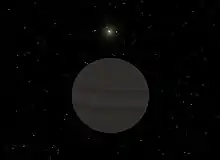Mu Arae e
Mu Arae e, also known as HD 160691 e, later named Sancho /ˈsæntʃoʊ/,[2] is one of the four extrasolar planets orbiting the star Mu Arae of the constellation Ara.
 Mu Arae e rendered by Celestia | |
| Discovery | |
|---|---|
| Discovered by | Butler, Marcy |
| Discovery site | California, |
| Discovery date | June 13, 2002 |
| Radial velocity | |
| Orbital characteristics | |
| Apastron | 5.750 AU (860,200,000 km) |
| Periastron | 4.719 AU (706,000,000 km) |
| 5.235 AU (783,100,000 km)[1] | |
| Eccentricity | 0.0985 ± 0.0627[1] |
| 4205.8 ± 758.9[1] d 11.51 y | |
| 2,450,541 ± 96[1] | |
| 57.6 ± 43.7[1] | |
| Semi-amplitude | 18.1 ± 1.1[1] |
| Star | Mu Arae |
In July 2014 the International Astronomical Union launched a process for giving proper names to certain exoplanets and their host stars.[3] The process involved public nomination and voting for the new names.[4] In December 2015, the IAU announced the winning name was Sancho for this planet.[5] The winning name was submitted by the Planetario de Pamplona, Spain. Sancho was the squire of the lead character of the novel El Ingenioso Hidalgo Don Quixote de la Mancha.[6]
The planet's discovery was announced on June 13, 2002. Mu Arae e is a gas giant at least 1.8 times as massive as Jupiter. The planet orbits at Jupiter-like distance at 5.235 AU.
References
- Pepe, F.; Correia, A. C. M.; Mayor, M.; Tamuz, O.; et al. (2007). "The HARPS search for southern extra-solar planets. VIII. μ Arae, a system with four planets". Astronomy and Astrophysics. 462 (2): 769–776. arXiv:astro-ph/0608396. Bibcode:2007A&A...462..769P. doi:10.1051/0004-6361:20066194.
- "Sancho". Oxford English Dictionary (Online ed.). Oxford University Press. (Subscription or participating institution membership required.)
- NameExoWorlds: An IAU Worldwide Contest to Name Exoplanets and their Host Stars. IAU.org. 9 July 2014
- NameExoWorlds The Process
- Final Results of NameExoWorlds Public Vote Released, International Astronomical Union, 15 December 2015.
- NameExoWorlds The Approved Names